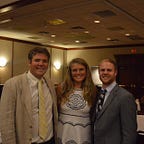Design for Change #5
Ch. 12 & 13; 12, 13, & 15
I like how they talked about their “fail often to succeed sooner” motto. No matter what we do, especially as design students, we are most likely going to fail the first few times. This helps us to mature as designers and learn how to expand our design process. I think everyone can agree that Thomas Edison said it perfectly, “I have not failed. I’ve just found 10,000 ways that won’t work.”
I find it really interesting how people are so afraid of failure that even of they have a really smart idea, they will shy away from sharing because they don’t think it will work out in the end. one example they used was the wireless mouse for the computer. The original designer didn’t go through with it and gave it to someone else. In the end it obviously became a big hit.
They talk about how the apple mouse only having one button because it would have been too much for people if there were two. After being an Apple consumer, I don’t find myself having that many issues with the mouse, but when I was learning, I found it very frustrating.
They then went on to talk about how Microsoft changed their mouse to be more user friendly. I was more comfortable to hold on to and extended the length of the entire hand. They made the buttons easier to use, making the right longer than the left because we use it more.
I found it very interesting that the author talked about drive-by designing for the ticket. Like he stated, we all redesign things to make them “easier” to work with, but if we don’t stop and do the research it could end up making things harder on people.
Design by dysfunction is also an interesting concept that he brings up. The fact that designs could be great but that the group could not work well together to make a great product is what can happen. If there are issues that arise, one change may be able to fix those issues, but most of the time it will not. Major parts of the organization that have a lot of say in what happens need to have a change before you really start to see changes taking place.
On the second to last page of chapter 15, I love how he brought up the fact that things like the airplane and even food has been created, but can end up hurting people. Obviously that was not what the designers had in mind when they created those products, but users spun them around to be what they were.
